When the second world war escalated, Beacon Woods again became a military training ground, as had been the case in previous conflicts over many centuries. It also became the location for an Auxiliary Operating Base and was the site of several tragedies.
Plane Crash in 1943
At 08:15 on the 12th April 1943, Flying Officer Arthur L. Barge and Pilot Officer Arthur J. Matthews of 264 Squadron, took off from RAF Colerne on a ‘ Day Ranger’ patrol mission. The aircraft, a De Havilland Mosquito (DD 727), was plotted as being on track by the Royal Observer Corp, but by 08:30 the plots faded near Shepton Mallet. The wreckage of the aircraft was found 1 mile due south of the Oakhill church, both men were killed.
In the accident investigation that followed it was noted that there was low cloud (400 feet) over RAF Colerne that became lower on the route. The aircraft hit the hill at approximately 300 feet above the aerodrome level (RAF Colerne is 581 feet AMSL). If the aircrafts altimeter was set at the aerodrome and there was no technical failure, then the altimeter would have read 500 feet at the point of impact. The map reference was noted as ‘Sheet 12 TU.0667’ (GSGS series ‘Purple Grid’ reference).
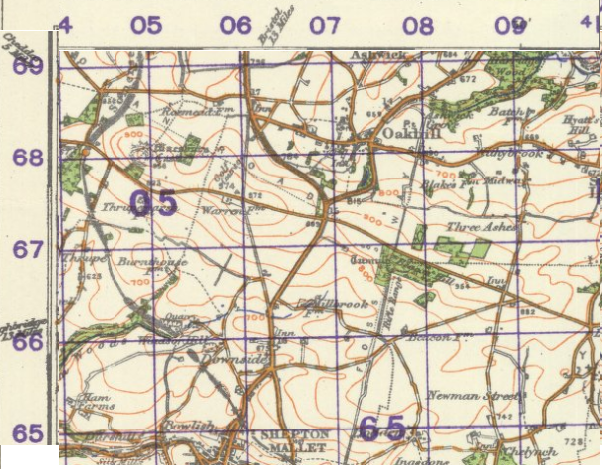
Sixty years later, the events of the day were recalled by Mr R.E. Wood who lived in Shepton Mallet during the war, he was a member of the local Army Cadets and a Civil Defence messenger.
“…the Mosquito crashed on the 12th April 1943, it came from Colerene and was piloted by a Free French pilot. He was flying south, extremely low from the direction of Oakhill and hit a tree in the south hedge of the Old Frome Road, this disabled the wooden Mosquito and it crashed in the area of the building at Lapwing Farm. I can remember seeing the tree with which the aircraft collided and it was damaged; I have marked the location on the map. From memory, the Mosquito did not catch fire, but was wrecked against the barn. it was fully armed with 20-mm cannon shells, which were thrown all over the area. this confirmed the Mosquito was the fighter variant, as the Bomber variant was not armed with 20 mm cannons. The Mosquito must have passed over some smoke canisters/phosphorous grenade shelters at about 15/20 ft before it crashed. Had it collided with the grenades, there would have been a massive explosion and fireball. The pilot and navigator were killed on impact…”
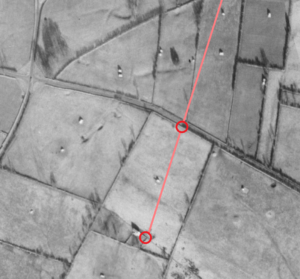
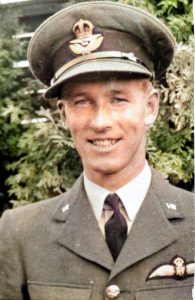
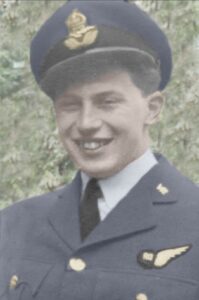
Arthur Barge was buried in Wansted, London, aged 27. The son of Arthur Leslie and Grace Ethel Barge, of Wanstead; husband of Betty Dorothy Barge, of Wanstead.
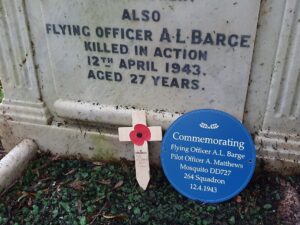
Arthur Matthews was buried at Lambeth cemetery, aged 23. The son of Arthur Alfred Matthews, and of Clara Alice Matthews, of Brixton; husband of Lilian Ellen Matthews, of Dulwich Village.
Sources
- GSGS Map – http://digitalarchive.mcmaster.ca/islandora/object/macrepo%3A66452
- Accident Report – NRA/AIR27/1555
- Accident Log – NRA/AIR27/1553/66
- CWGC
- Eye witness account by Mr R.E. Woods
Mortar Incident
During the second world war the lower part of Beacon Wood was used as a mortar range on the 18th April 1941 an accident at a training event led to tragic consequences. The Shepton Mallet Journal for the 2nd May 1941 describes the incident that led to the death of four soldiers:
“Tragic Death of Four Soldiers. Premature explosion at a Demonstration.
The deaths of four soldiers through the premature explosion of ammunition from a trench mortar was described to the Coroner for South East Somerset (Mr. G. L. Rutter) at an inquest on Monday .
The dead men are: – Fusilier Thomas May (24), of 79, Matilda Street, Newcastle-on-Tyne: Sergt. Joseph Spence Pick (30), of 26, Waverley Cresecent, Lemington-on-Tyne; Lance Corporal William Foster Scott (21), of 8, Linum Place, Fenhuam, Newcastle-on-Tyne: and Lance Sergt. Thomas James Bradley (29), of 8, Chiefwood Road, Melrose, Scotland.
After evidence of identification, the officer commanding the regiment stated that he ordered a demonstration of a mortar platoon coming into action. The battalion was lined up as spectators in a semi-circle about 25 yards from the mortar. The detachment nearest the mortar commenced to fire and the first round was normal. The second round appeared to have exploded immediately on leaving the muzzle of the mortar, because although he was not watching it at the time he heard the explosion, and on looking around at the battalion he saw men on the ground and smoke clearing from the mortar. He then found that a number of officers and other ranks had been hit. Casualties were removed, and he ordered the mortar and remaining ammunition to be left untouched. All proper precautions were taken, and he believed that no blame could be attached to any person. A technical enquiry was being held and attended by an expert.
The Cororner asked if this evidence would be available for the adjourned hearing, and the officer replied that he thought parts of the document would be privileged.
The Coroner said he could hold parts of the enquiry in camera. Otherwise he would only be able to bring in an open verdict, which was unsatisfactory from his point of view.
The Medical Officer of the Regiment said one soldier was dead on admission to hospital, two died the same day and one the following day. He thought it likely that there would be at least one more death. The cause of the death in each case was shrapnel wounds.
The inquest was adjourned to Friday, May 9th.”
The event was also noted by Mr R.E. Wood sixty years later:
“I understand the Shepton Mallet Town Ambulance was used to evacuate the casualties. The military unit involved was stationed locally, possibly from the Royal Northumberland Fusiliers or the Middlesex Regiment. The range was to the west of the Fosseway leading up to the Beacon from the south. The target area was on the west slopes of Beacon Hill. As a 3″ Mortar had a maximum range of 2,000 yds and a large bomb with the same explosive effects as an RA 25 pdr HE shell, the probability is that the accident involved a 2″ Mortar with a range of 525 yds and a bomb comparable with a high explosive No 36 Hand Grenade. For range safety I am sure the use of a 3″ Mortar would have been prohibited as it could have almost reached Oakhill if the range was incorrectly set. From memory there was one or more fatal casualties. The Ambulance attendant in those days was a Mr Bert Mees of Cemetery Lodge, Waterloo Road, Shepton Mallet, whom I am sure attended the incident. Bert was also the 2 i/c of Shepton’s National Fire Service Unit (NFS) in WW2 and travelled with them to fight fires arising from air raids in Bristol, Bath and Avonmouth. Bert’s son Eric, who was about 16 years of age at the time, now lives in Bridgwater and may be able to provide additional details.
After we learned of the accident, some of us, possibly including Eric, cycled up to Yellingmill Lane to see what was happening. (This was not a ghoulish activity but as lads we cycled to every plane crash to obtain souvenirs, every bomb crater to collect fragments, we collected propaganda leaflets dropped by the Germans and we loved to see tanks etc. all of which were of great interest.) I estimate the firing point and scene of the accident was at Map Reference 634453, north of Yellingmill Lane. It was rumoured when the mortar was fired the bomb hit the branch of a tree and exploded, causing the casualties to the mortar team. I am unsure of the location of the ‘Secret Army’ bunker, but it must have been away from the 2″ mortar HE impact area.”
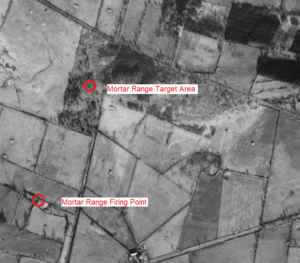
The Commonwealth War Graves Commission records the casualties below:
- Fusilier Thomas May Burns
- Serjeant Joseph Spence Pick
- Lance Corporal William Foster Scott
- Lance Serjeant Thomas James Bradley
Small Arms Range
The rifle range at the Beacon had been in use since at least the 1860s, but for the Second World War period Mr R. E. Woods gives the following description:
“I was unaware if the range was in existence before WW2, but I think it probably was. If so it may have been used by the local TA, which was a Battery of the West Somerset Yeomanry (TA) who were located at the Drill Hall in Charlton Road. Any survivor could inform on this. Mr Stan Blacker, former Somerset President of the RBL, who lives in Shepton, ex WW2 Royal Marines could advise on surviving members of the Battery.
The Shepton Mallet Company of the Home Guard, the 4th (Frome) Battalion used the range. Major Luff of Bowlish commanded the company. A Platoon Commander was Lt Bennett who owned the Anglo Bavarian Brewery property in Commercial Road. The permanent Staff Instructor seconded from the Army was a CSM Giddings and the Home Guard CSM was CSM Stevens who lived near the Crown Inn in Cowl Street. His daughter, Nancy Emery lives in Shepton. The Company Headquarters have now been demolished, but was on the south side of Commercial Road, near the roundabout and adjacent to the Police Station/old Fire Station.
With some members of the Shepton Mallet Platoon of E Company, The 4th (Army Cadet) Battalion, The Somerset Light Infantry, I used to attend the Beacon range practices of the Home Guard and we operated the Field Telephones from the Firing Points to the Butts. The Home Guards used to fire their US Lease/Lend .300″ P17 Rifles and Browning Automatic Rifles. These Weapons were manufactured by America, used in WW1 and subsequently stored. They were returned to the USA post WW2.
The range practices were commanded by a Capt Norgrove, whom I think served in the Royal Marines in WW1 and worked at Showerings, his son used to live in Shepton. When we attended the range there was a large pit in the butts to safely accommodate the party who raised and lowered the targets and range safety equipment such as the red danger flags. I can not remember any storage facility in the pit in the butts under the targets. As it was only a small range, there was not the usual vertical crashes to hold targets where one target was displayed for firing and the second target was underneath it being pasted up. The targets were swivelled on a pivot and swung 180 degrees, the upper target being used for firing and the second was below it for pasting up, then swung 180 degrees for use. This was a crude device but it suited a small range as it was vandal proof, there not being a full time Range Warden. I can never remember seeing any formal notices to inform the public about safety aspects of the range or the significance of the red danger flags, flown on the Old Frome road and the Fosseway when the range was in use.
One evening we were walking in the area and heard the sound of heavy machine guns being fired on the range. Much louder than a Bren .303″ LMG or the Browning BAR and we walked to investigate. We found a group of US Army soldiers firing a Browning .50″ Heavy Machine Gun (Known as the 50 calibre and still being used in Afgahnistan today by the US Army and the Royal Marine Commandos) The Brownings were mounted on US Army trucks. There was hatch above the seat alongside the driver for anti aircraft observation and the Brownings were located on a ring above the hatch. There were three or four Brownings firing at the butts for a considerable time and the damage inflicted must have been horrendous, as the distance to the butts was only about 150-200 yards. I am sure the Americans were either Military Police from the 2912 Disciplinary Training Centre (DTC) located at Shepton Cornhill Prison or from the US Army Ordnance Corps at the large fuel depot at Maesbury S&D Railway Station. (Now Rocky Mountain Garden Centre.)
After a time the Home Guard ceased using the Beacon Range and used to fire in a disused quarry at Map reference 611452, which was a very crude arrangement with no butts, telephones and relied on whistle signals. Perhaps it was after the Americans use of the Beacon range, rendering it unsafe, that an alternative site had to be found as the damaged range did not meet the Safety Regulations with the Old Frome Road running just behind it. The Quarry belonged to Major Luff hence the use. An adjacent quarry was used by the Home Guard for throwing the No 36 HE Hand Grenades also owned by Major Luff.
After WW2, the Home Guard were disbanded and the Territorial Army was put in suspended animation until reformed in about 1947, so there was not a requirement for a Small Arms Range at the Beacon. I understand Beacon range was repaired as a voluntary activity led by Flt Lt Horler, from Croscombe, CO of the Wells ATC Squadron in a private capacity for use by a Rifle Club. Possibly a post WW2 Home Guard Rifle Club for a period. This was only in use for a short time as they then used the Yoxter range. I was there in 1954 onwards with the North Somerset Yeomanry TA, who used the accommodation for a weekend training and the Home Guard Rifle Club used to shoot on the Yoxter Range.”
Ammunition Dump
The Royal Army ordnance Corps sited an ammunition dump on many of the roads around Beacon Hill. The operational headquarters were some Nissen Huts located in a field at Long Cross, marked on the map. The ammunition which was mainly smoke generators and non phosphorus emission smoke grenades (No 79 Smoke Grenades) stored in mini Nissen huts, approx 8 ft x 14 ft along many of the roads in this area. If the verge was wide like part of the Old Frome road directly to the north of Beacon Wood, the ammunition huts were sited on the verge alongside the road. If the verge was narrow the huts were placed inside the farmer’s field on the other side of the hedge and surrounded with barbed wire to keep the cattle from entering.
The Old Frome Road to the west of Beacon hill had narrow verges on the south/Shepton side and the ammunition huts were sited in the field behind the hedges. But where ever possible the huts were located on the roadside as it was easier for loading/unloading the ammunition. I never saw a guard or patrol looking after the ammunition, it was just left there. I have marked the area of the ammunition huts that I remember on the attached map.
The accommodation barracks for the RAOC soldiers were located in Shepton at Sales House, in Draycott Road, near the Crown Inn at the bottom of Cowl Street. Sales House seems to have been converted to flats. One soldier was killed falling out of a window and is buried in Shepton Cemetery.
When the US Army came to the UK in 1942/43, a detachment of the US Army Chemical Corps took over Sales House and the ammunition dump on the Mendips. They also used it to store smoke generating ammunition, mainly green cylindrical cannisters about 2/3 ft in height with a diameter of about 9″. These did not contain phosphorous for instantaneous smoke, but were of the smoke emission type. However the US Chemical Corps stored large quantities of Phosphorous Hand Grenades, used for instantaneous smoke screens by their Infantry. As per US Army practice, these grenades were manufactured and stored primed with a detonator for immediate use. This differed from the British Army who always stored No 36 HE Grenades and the No 80 Phosphorous Instantaneous Smoke Grenades un-primed and the detonators were only inserted, arming the weapon when it was required for use. The primed US Phosphorous Grenades were stored in the open in unguarded shelters, which seems incredible today as they were lethal, perhaps more lethal than an HE Grenade. By the Geneva Convention, these phosphorous grenades should not have been used against human beings, but from reading accounts of the North West European campaign, they were frequently thrown in to pill boxes, strong points, dug outs etc. as the occupants could not shelter from the effects of the burning, smoking phosphorous which permeated everywhere. British Infantry were most reluctant to carry phosphorous grenades in their ammunition pouches as they exploded if bullets or mortar/shell fragments penetrated the outer case, the phosphorous exploded with horrendous effects on the soldier. most of the US phosphorous grenades came from the Mendip dump.
During the Rhine Crossing in 1945 at the final stages of WW2, a continuous smoke screen was laid for two days in exposed areas to cover the preparations for the crossing, a very hazardous operation. it was said all the smoke canisters came from the Mendip site.
At some stage post WW2 all the ammunition shelters were removed. The smoke canisters and grenades seemed to have survived the barrage of the US Army’s 50 calibre shoot as the rounds were ricocheting everywhere and some shelters were in direct line of fire from the range. I would not liked to have been travelling along the Old Frome road when this activity was taking place.